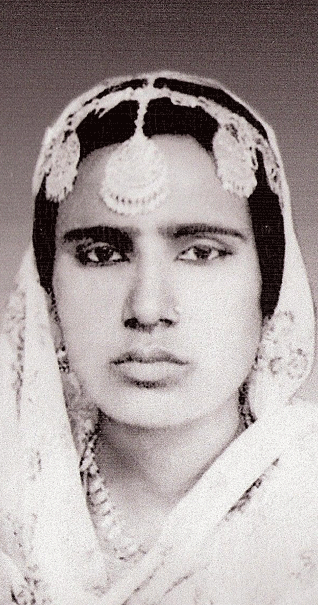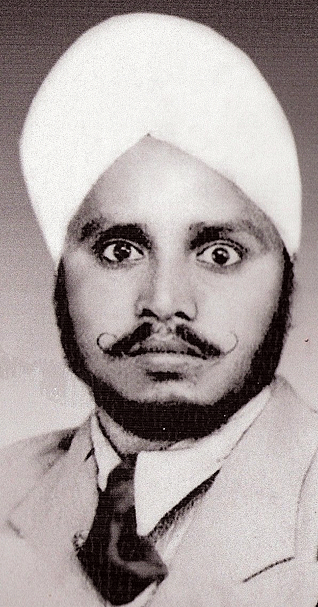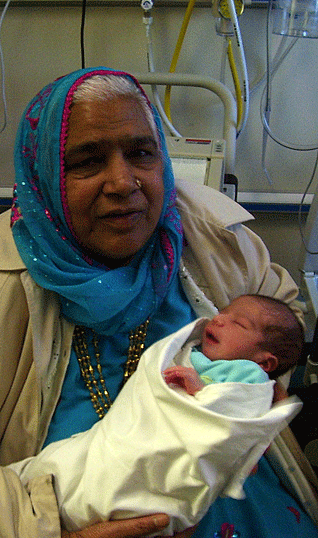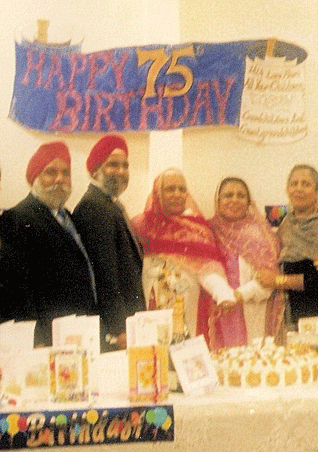
Above: Sardarni Lachmi Wanti Kaur. Below, first from bottom - at her 75th birthday celebrations. Second from bottom - with her great-great-grandson. Third from bottom - Sardar Karnel Singh.



History
The Queen From Edinburgh
by MIKE WADE
A remarkable journey, which began sixty years ago, when a heavily pregnant Sikh woman walked to safety from the strife-torn region of the Punjab, has ended in December, 2007 in Edinburgh, Scotland.
The body of Sardarni Lachmi Wanti Kaur Landa, 86, dressed in fine robes of peach and powder blue, was laid to rest at the centre of a crematorium chapel in Leith.
To her right, an elder (bhai ji) in a golden jacket led a chant that was taken up by hundreds of men crushed in around the dead woman. "Satnam Waheguru", they sang, "The truth of the creator is eternal", lifting their prayers to heaven for one of the most significant and beloved of women, whose life story echoes the experience of the entire Sikh diaspora.
No one could doubt the depth of feeling for Lachmi Wanti Kaur, whose passing meant so much to so many. She bore eight daughters and six sons. Between them, her children have produced 63 offspring. There are 85 great-grandchildren and one great-great-grandchild, Luckvinder Singh.
A further 34 wives and husbands have married into the clan. All are members of a family who knew this woman as "the Queen of Queens".
Edinburgh's Sikh community numbers between 500 and 600. Lachmi Wanti, who died after a short illness in early December, 2007, almost twelve years to the day since her husband passed away, was directly related to more than a third of them.
In the funeral home, the crowd kept moving forward. From the pews in the body of the kirk, older women in white robes shuffle up to the coffin. They approach the body to touch the dead woman's feet, paying her the respect which to age is due.
Finally, after the coffin lid had been brought from the south wall of the chapel, it fell to Akbal "Aaki" Singh, the matriarch's eldest son, to push the button that consigned the body to cremation.
An hour later, in Leith's Gurdwara, the family could at last come to terms with their grief.
"She was very highly respected by everybody", said Aaki Singh. "She loved to give people things. She spread happiness. She never had a bad word to say about anyone. If someone said a bad thing about another, she would say, 'Never say that'. She was a peacemaker".
Born in Lahore, Lachmi Wanti Kaur's journey to Scotland began after her marriage to Karnel Singh. Sikh tradition dictates that a woman joins her husband's family and the couple set up home in Gorashah in 1944.
This was the time leading up to Partition, the division of India and Pakistan by the British authorities, which led to a form of ethnic cleansing, as Sikhs were forced to flee from West Punjab to make way for Pakistan, and reprisals took place against the Muslims in the newly-carved India.
Eight months pregnant, and leaving all her possessions behind, Lachmi Wanti was among thousands of refugees forced to walk the hundred kilometers which led to safety in the town of Phagwara, southeast of Amritsar, in the Indian Punjab. Here, her first daughter, Raspal Kaur, was born in August 1947. Four more children would come into the world in Phagwara and Ludhiana, before she followed her husband to Britain in 1958, and settled with her family on St Mary's Street in Edinburgh.
"When we came to Edinburgh, we were welcomed with open arms, not as if we had come from some foreign land. Until I was 16, I didn't even realize I was 'coloured' - this is why our love for Edinburgh is so great", said Ragbir "Rab" Singh, who came to the city at the age of four.
"There was a difference in England, a kind of segregation. We came from a community with love and care. I was welcomed into my friends' homes at Christmas or at any other special occasion. That was the love we got from Scotland and Edinburgh".
The family have moved around, briefly as far as Birmingham, but mostly in Edinburgh, to Gayfield Square and now a little further north, to Pilrig.
Some of Lachmi Wanti's children have been trailblazers. In 1971, Aaki was the first Sikh to win his case as a bus conductor and to be allowed to wear a turban to work. Many of the men have been shopkeepers with premises of their own; others are property dealers. Some work in the community; others in big city stores.
These days, many of the younger women are not content with just being housewives, and take jobs, unlike Lachmi Wanti, whose life was dedicated to her husband, her children, and her children's children. But all honour and adore her: she will never be forgotten.
"She was more than a mother to us", said Jagdish Kaur, who married Aaki Singh in 1969. "One of her babies came after my own first child. She was very beautiful. We looked after her like a queen. She was a queen".
[Courtesy: The Times - Scottish Edition. For more my Mike Wade: http://mikewadejournalist.blogspot.com/ ]
Conversation about this article
1: Gurpal Singh (Wolverhampton, U.K.), December 22, 2007, 4:19 PM.
A lovely story: a life celebrated. Many of your readers may not realise that the Edinburgh Sikh Community and the Landa family in particular are representative of a distinctive element of the British Sikh Community; the Bhatras or Bhats. The Bhatras were the first significant group of Sikhs to settle in Britain a century ago, establishing the first Gurdwaras, mainly in port cities. I had the good fortune to know the community well. I lived in Cardiff for three years while at university, where they have a large community with two Gurdwaras. One of them, S. Jaswant Singh Jas is Wales' only elected Sikh councillor. My landlord for the summer period of University was a Bhatra Sikh and he treated me as one of the family. I also have a Keshdhari Bhatra Sikh friend who now works in the City of London in finance whose family also adopted me, with regular invites to family weddings and akhand paths. When I moved to do postgraduate studies at the University of Portsmouth in 1995-6, I found the local Gurdwara was run by Bhatra Sikhs. The leader of the community had settled there before the last World War and he remembered meeting Shahid Udham Singh in London. They are found in significant numbers in East London, Portsmouth, Southampton, Cardiff, Swansea, Bristol, Manchester, Birmingham, Glasgow, Dundee and Edinburgh. They keep to themselves and some are wary of being dominated by Sikhs of other backgrounds. They have had a past history of serving meat in Gurdwaras, which they justify by mentioning that nihang Sikhs traditionally sacrifice goats at Vaisakhi and Hola Mohalla at Hazur Sahib and Anandpur Sahib. I had an opportunity to partake in an incredible and bizarre wedding langar at a Southampton Gurdwara in the mid-90s: bacon, sausages, eggs, toast and beans. Their most outstanding trait is their commitment to the visible symbols of Sikhism, particularly kesh. A visit to a Bhatra Sikh Gurdwara will be an opportunity to see an overwhelming number of turbanned or top-knotted children. Sikhs like Mata Lachmi Wanti Kaur have truly enriched the lives of Britain's Sikh Community.
2: Brijinder Kaur Khurana (Delhi, India), December 24, 2007, 1:38 AM.
Great story. We must learn from this story: peace and unity are so important at home.
3: Bhupinder Singh Ghai (New Delhi, India), December 24, 2007, 2:24 AM.
The Sardarni lived her life as a true Sikh, always happy and abiding by Guru's will. That might be the secret of her longevity. We could take lessons from her. A note for S. Gurpal Singh: Thank you for the valuable insight into the Bhatra community, but may I ask, have they forgotten that once you are a Sikh, caste or clan or even race become meaningless? It is high time we realize this. Also about serving meat at gurdwaras, it is a sacred place and you really cannot justify serving meat there by any distorted logic. Nihangs were allowed to consume meat only during wartime and only when survival was at stake. We, I mean the majority of Sikhs, consume a lot of meat anyway. So, I think we can do away with this bizarre practice within the gurdwara.
4: Harmeshe Roth (Leeds), May 30, 2008, 6:31 PM.
I didn't know her as well as my own granny who is her little sister, but when I used to see her occasionally, she had this warmth that would come from her smile, as she said hello.
5: Trishna Kaur Kasbia (Edinburgh, Scotland), January 11, 2009, 5:48 AM.
I am part of the Bhatra community in Edinburgh and know this family really well. I have just come across this article and feel very proud that so many comments have come from far and wide and would like to take this opportunity to thank you all for all the comments they are both very positive but also have given me some really good info to put together to take to my Punjabi class and discuss with the group. As for the comments about meat in the gurdwaras, this has always been a real problem and there seems to be conflict around it at all times but some of the comments that I have read have thrown some light on it and will assist me in getting the message across, hopefully open up the discussion without causing too much conflict.
6: Gurmukh Singh Roudh (London, England), November 09, 2009, 12:39 PM.
Very well written article depicting early migration from Punjab.


